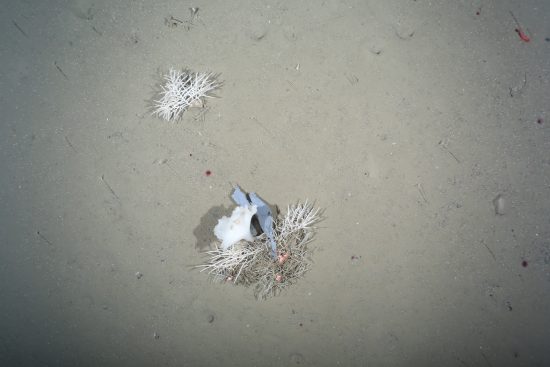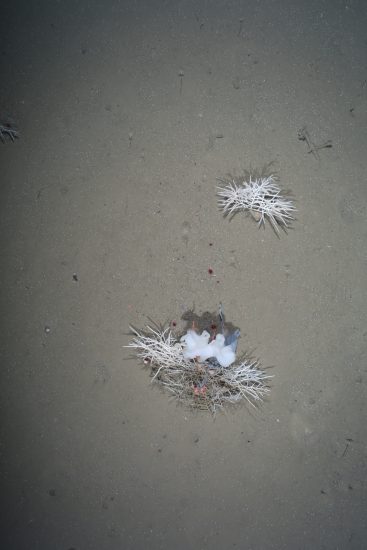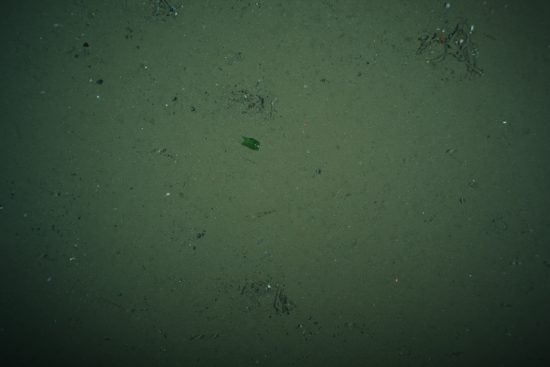




Sea ice may be responsible for transporting plastic waste
The Arctic has a garbage problem. In just a decade, the amount of
litter at an Arctic deepsea station has increased 20-fold. This was the
finding of a study by scientists from the Alfred Wegener Institute,
Helmholtz Centre for Polar and Marine Research (AWI).
Plastic bags, glass fragments and fishing nets: Despite being far away
from any metropolitan areas, the amount of litter in the depths of the
Arctic has been increasing, posing a threat to the sensitive ecosystem.
Since 2002, AWI scientists have been measuring litter at two stations
in AWI's Hausgarten. This is a deep-sea observatory network, comprising
21 stations in Fram Strait between Greenland and Svalbard. The results
of this study have now been published in the Deep-Sea Research I
journal.
In the research, the scientists used the OFOS (Ocean Floor Observation
System) remote-controlled camera system to observe the seabed at a
depth of 2,500 metres at the two stations.
Since the start of the
research, they discovered 89 pieces of litter in 7,058 photographs.
Since they can only observe a relatively small area with the cameras,
the scientists extrapolated the litter density to a larger area. As a
result, for the monitoring period of 2002 to 2014, they found an
average of 3,485 pieces of litter for every square kilometre.
In addition, they noticed the upward trend in the amount of litter
amount.
For 2011, the amount was 4,959 pieces per square kilometre, at
amount which they hoped was simply a statistical outlier. However, the
amount of litter continued to increase since then, peaking at 6,333
pieces of litter per square kilometre three years later.
At the network's northern station (called N3), the situation was much more dramatic. “Here, the amount of litter rose more than 20-fold between 2004 and 2014,”
said AWI biologist Mine Tekman.
Based on the findings for the northern
research area in the marginal ice zone, the 2004 data indicated 346
pieces of litter for every square kilometre. A decade later, the amount
rose to 8,082.
The contamination level is similar to that of one of the
highest litter densities ever reported from the deep seafloor, in Cap
de Creus Canyon off the eastern coast of the Iberian Peninsula.
Plastic and glass were most often found among the litter. This is
because glass does not drift over long distances, but tends to sink to
the seabed. Its prevalence suggests that they had originated locally;
and the increasing ship traffic in the region due to the receding ice
supports this. As for the plastic litter, determining its origins isn't
easy, as it often travels a considerable distance before reaching the
seabed, and just using photographs isn't enough to go on.
The influence
of the Gulf Stream in the movement of plastic in the Arctic is
undeniable. The scientists' research suggests a positive relationship
between litter density and the summertime expansion of sea ice. “If
we’re right, sea ice could entrain floating litter during ice
formation. During warmer periods, the ice breaks up and is transported
to the south into the Fram Strait with the Transpolar Drift, releasing
entrained litter into the survey area when it melts,” said deep-sea biologist and co-author Dr Melanie Bergmann. “To date we’ve assumed just the opposite, since we viewed the ice as a barrier to litter contamination.”
However, the researchers continue to puzzle over when and how plastic
litter changes as it is transported to the deep sea. Over time, they
observe increasingly more small bits of plastic, possibly the result of
the larger pieces of litter breaking up, and contributing to a growing
amount of microplastic.
The researchers found it puzzling that the
plastic managed to disintegrate, despite the lack of ultraviolet light
and the low temperatures.
In summer 2016, the researchers encountered “an old friend” – It was a
piece of plastic they had encountered two years earlier. Accord to
Bergmann, “Running into this same
piece of plastic twice with hardly any changes to it is a vivid
reminder that the depths of the Arctic are at risk of becoming a depot
for plastic litter. The well-hidden accumulation of litter on the deep
ocean floor could also explain why we still don’t know where 99 percent
of the marine plastic litter ends up.”
Link to the study
 Herbert
Herbert 16th February 2017
16th February 2017